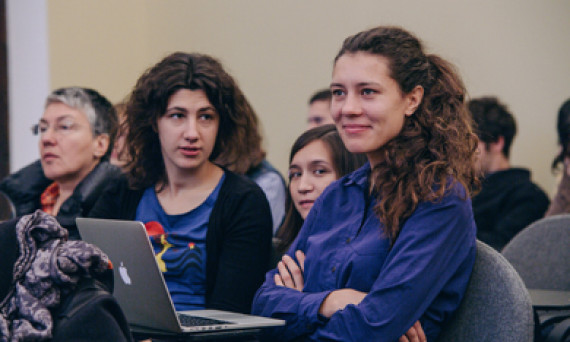The section “Migration: The Period of Limitations (The North and Immigrants) took place as part of the conference VDNH. This section was noteworthy as it presented the results of the work of two actively developing academic trends within the EUSP — social studies of the Arctic and Siberia, and the anthropological study of migration.
Both of these trends are represented within the university by two professorships in Arctic Social Sciences— one is a university professorship (professor Nikolai Vakhtin), and the other is sponsored by the BP corporation (professor Sergei Abashin). Conference organizers decided to combine these research directions in a single conference section as a demonstration of how migration processes constitute an immensely important topic for contemporary Russia’s Siberian-Arctic zones. In this sense, migration processes can be considered from the point of view of regional studies as well as the perspective of their own construction (migration studies).
The topics within this frame were linked with the research project currently curried out in EUSP "«The children of the 1990-s in the contemporary Russian Arctic: evaluation of the present and desired future (grant of the Russian Science Foundation 14-18-02136).
Results from a project on a study of migration from the Caucasus to Siberia were presented in the first part of the section. Colleagues of the EUSP participated in the project as part of the professorship in migration studies. Denis Sokolov (RANEPA) spoke on the economic and institutional prerequisites for the migration of immigrants from the Northern Caucasus to the Tyumen region, having presented a range of life strategies of immigrants in different periods. Sokolov also described the function of Islam and elements of the traditional cultures of immigrant groups in their new places of residence.
Akhmet Yarlykapov from the Russian Academy of Science’s Institute of Ethnology and Anthropology gave a report titled “The Russian North in the Fate of the Nogai: Posing a Problem,” where he addressed the issue of how societies function in a new place of residence. Yarlykapov viewed these issues to a greater degree through a prism of a people’s ethnic history, and also examined the diachronic aspects of social studies, drawing parallels to contemporary situations.
Ekaterina Kapustina (EUSP) gave a report on field research conducted in the same region, where immigrants moving between Dagestan and Western Siberia were considered in the context of the function of trans-migrational space and the problem of “their land.” Kapustina elaborated on the micro-history of human destinies and the search of ethnic groups and their individual members for a new identity in a new location.
The second group of presentations centered on the function of migration processes considered from the point of view of the regions in which they occur—Russian Siberia and the North. This approach has been developed for several years within the university’s professorship “Social Studies of the Arctic”. Andrian Vlakhov (EUSP) presented the results of his 2014 field research in a report titled “One’s Own Among Strangers: Contract Labor Migration to Svalbard.” Vlakhov described the social structure of the Russian settlement in Barentsburg and migration processes taking place in the framework of Russian coal mining in the archipelago. Alla Bolotova (EUSP) gave a report titled “How the North Became Home: ‘Former Migrants’ in Murmansk Oblast,” in which she considered the problem of historical memory of the first generation of settlers on the Kola Peninsula and changes in their regional self-identification over time. Bolotova also classified migrants based on their time of settlement, considering this phenomenon from a historical perspective.
In her report “Who is Considered Local? On Various Migrational Layers in the Yamal Region of the YNAO,” Elena Lyarskaia (EUSP) examined the region from a diachronic perspective, isolating several different migration flows through time. Lyarskaia focused on the functioning of these different migratory “layers” in contemporary society and gave a detailed description of the anthropological particularities of the life style in this region.
The last was delivered by Irina Popravko (Tomsk State University). Although she considered a slightly different geographical location within the region of study, Popravko also discussed migrant groups in the post-Soviet space. She discussed the role of language, space and time as instruments of categorization in the context of repatriations problems in contemporary Kazakhstan, giving a detailed historical account of the issue, the judicial context of repatriation processes, as well as primary aspects of ethnic identification for the groups studied.
In concluding remarks, professor Nikolai Vakhtin noted that the processes described, representing various regions and different ethnics groups, differed significantly in essence. The first expressed a primary interest in economic factors, the second in the uniqueness of ethnic identity and the third in the historical aspects of migration processes. Professor Vakhtin pointed out that perhaps the term “migration” is insufficient to reflect the whole variety of phenomena presented in the section’s reports. In reply, professor Sergei Abashin noted that an appropriate theoretical approach has already been developed under the concept of transnationalism. When applied to studies of Siberia and the North, it can yield important results from a scientific standpoint.
Andrian Vlakhov











